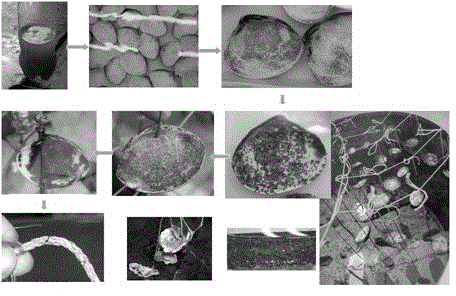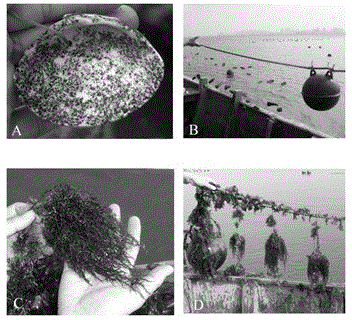Filament seedling and mariculture method of grateloupia filicina
A breeding method and technology of centipede algae, applied in botany equipment and methods, seaweed cultivation, climate change adaptation, etc., can solve the problems of inability to carry out large-scale cultivation, easy pollution, artificial breeding restrictions, etc., and achieve high-quality artificial breeding and breeding Effect
- Summary
- Abstract
- Description
- Claims
- Application Information
AI Technical Summary
Problems solved by technology
Method used
Image
Examples
Embodiment 1
[0028] Centipede algae (Grateloupia filicina) filaments 2g (fresh weight), crushed in a tissue grinder until each segment of filamentous algae contains no more than 10 cells.
[0029] The broken filaments were inoculated on clam shells and left to stand; 2 days later, adding seawater medium rich in inorganic nitrogen and phosphorus for light cultivation, the surface light intensity was 52μEm -2 the s -1 , The light-dark cycle is 12h:12h. The seawater was replaced every 5 days, and cultured with aeration after 10 days. After 20 days, the clam shell surface was covered with discs; 25 days, upright branches grew; 40 days, the shells were covered with 1-2mm centipede algae seedlings, and the cultivation process was as follows: figure 1 shown.
[0030] figure 1 The cultivation process in is divided into the following steps according to the direction of the arrow: the state of centipede algae filaments → the filaments collect shells → form discs → the discs produce upright sho...
PUM
 Login to View More
Login to View More Abstract
Description
Claims
Application Information
 Login to View More
Login to View More - R&D
- Intellectual Property
- Life Sciences
- Materials
- Tech Scout
- Unparalleled Data Quality
- Higher Quality Content
- 60% Fewer Hallucinations
Browse by: Latest US Patents, China's latest patents, Technical Efficacy Thesaurus, Application Domain, Technology Topic, Popular Technical Reports.
© 2025 PatSnap. All rights reserved.Legal|Privacy policy|Modern Slavery Act Transparency Statement|Sitemap|About US| Contact US: help@patsnap.com


